

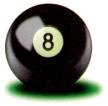
If necessity is the mother of invention, then the trials and tribulations
of matrimony have surely produced a myriad of contraptions, solutions
and fixes over the millennia.
Chalk up the Eight-Ball as the latest invention born of matrimonial
necessity. This potential relationship-saver is the brainchild
of John Borszcz, service manager at R+E Cycles in Seattle.
Borszcz is a thinking man's cyclist, and so he began conjuring
up a special sort of tandem, a tandem capable of a multi-month
tour of Europe, but not a cycling-specific tour. Therefore the
tandem had to break down into manageable pieces that could be
divided up and carried easily by him and his wife, Catherine Willis,
when they wanted to travel by means other than pedal power.
The Eight-Ball, a 24-inch wheel tandem with a frame divided into
eight sections with 10 S&S couplings, is the result of this
musing. It's just what Borszcz wanted--and more, as things turned
out. This tricked-out tandem is not only a super S&S tandem,
but converts to a single bike, as well.
We had a chance to observe Borszcz assembling the Eight-Ball on a trip through Eugene. Unfortunately, the bike didn't stick around long enough for a full test. Which is too bad, because this hot little number--that began as a one-of-a-kind custom--has received such raves wherever it's been seen that it is now a fully viable option from R+E Cycles. We did have an opportunity to talk with Borszcz to find out a bit more about his oddball tandem.
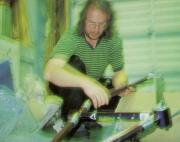 1.On your mark, get set, go! John starts by putting together
the lots of little frame pieces connected with the 10 S&S
couplers.
1.On your mark, get set, go! John starts by putting together
the lots of little frame pieces connected with the 10 S&S
couplers.
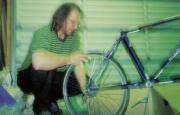 2. After the frame comes the 24-inch wheels, handlebars and cranks.
2. After the frame comes the 24-inch wheels, handlebars and cranks.
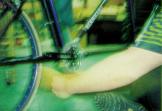 3.Threading in the cables harness. A different harness for the
single and the tandem make that connection simple. Check out that
RaceFace crank.
3.Threading in the cables harness. A different harness for the
single and the tandem make that connection simple. Check out that
RaceFace crank.
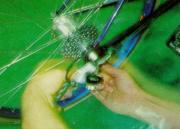 4. Skip to the transmission center--an older Shimano XT rear derailleur
and Sachs 3-speed hub that makes up the 3x7 system. John Dials
it in as the clock ticks past 20 minutes.
4. Skip to the transmission center--an older Shimano XT rear derailleur
and Sachs 3-speed hub that makes up the 3x7 system. John Dials
it in as the clock ticks past 20 minutes.
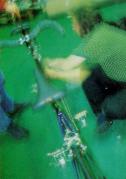 5. Spinning on Campy pedals finishes off the transformation from
non-descript cardboard box to travel-ready tandem--in less than
30 minutes. Notice those swanky moustache bars, light Avocet Air
02 seats, and the unlikely U-brake.
5. Spinning on Campy pedals finishes off the transformation from
non-descript cardboard box to travel-ready tandem--in less than
30 minutes. Notice those swanky moustache bars, light Avocet Air
02 seats, and the unlikely U-brake.
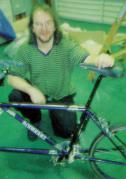 6. Proud papa with his first-born, the Eight-Ball.
6. Proud papa with his first-born, the Eight-Ball.
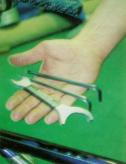 7. Everything you need to put together the Eight-Ball. Two hex
keys and a combo 15mm pedal wrench/S&S coupler-wrench. And
a couple more hands, of course.
7. Everything you need to put together the Eight-Ball. Two hex
keys and a combo 15mm pedal wrench/S&S coupler-wrench. And
a couple more hands, of course.
TM: John, tell us how you came up with the Eight-Ball.
JB: Well, my wife and I wanted to travel in Europe and
thought it would be nice to take along a tandem. For us, it really
wouldn't be practical unless it was small and compact. So, the
idea of making a tandem with 24-inch wheels with some extra couplings
in it seemed like an obvious thing to do.
TM: So you wanted to get it down even smaller than a regular
S&S tandem, but didn't want to go so far as to build around
20-inch wheels?
JB: Yeah...I'd heard some complaints about 20-inch wheeled
tandems not being particularly stable, or not even so much as
that as things like excessive tire wear, difficulty with braking
and so we came up with the 24-inch wheel format, sort of a real
small, compact frame with really long seatposts. You know, sort
of a la Bike Friday and Alex Moulton and that kind of thing.
I had considered a Tandem Tuesday before because they are a real
nice product, but you know, having a frame shop available and
somebody who was willing to work on the design, we came up with
something a little bit different. Something a little more, uh,
actually a little more of a conventional design than a Bike Friday.
TM: What about the convertible part, how did that come
about?
JB: Well, in sitting down and designing the frame and positioning
the couplings to break it down as small as possible it got to
be pretty obvious that it could be broken down into a single.
TM: So that wasn't something you originally had in mind?
JB: No, that was sort of an after-thought to the original
design. The primary idea was to have a tandem that was small and
that we could travel with easily. Just something that was compact.
Having a single built in is just a great feature for us.
TM: Since you built this for yourself, what are some of
the component hightlights?
JB: One of the biggest would be the Sachs 3x7 hub. This
allows a couple of things: it makes the cabling a bit simpler
and eliminates the front derailleur--and front derailleurs can
be a bit of a hassle setting up on a take-apart tandem. It also
allows us to put the timing chain on the right side of the bike
as opposed to the left, so it uses conventional cranks. That was
a good design parameter.
Also we used a Sachs drum brake on the front for a drag brake
because the smaller wheels, because of a lack of leverage, require
some extra stopping power. It works great. It use it when it's
set up as single riding to work. I have some long hills and descents
between my house and the bike shop and I'll just ratchet up the
drag brake and drink my coffee while I coast down the hill.
TM: Sounds pretty smooth, John!
JB: Yeah, overall I'd say so. We have a nice set of RaceFace
cranks and some nice old Campy pedals with clips and straps--we'll
be traveling and using recreational shoes, and don't need any
clipless pedals.
Not too much fancy stuff, but 36-hole Sun Metals rims and DT spokes
make a bulletproof wheel at 24 inches. We also did the mustache
bars because they pack nice and flat.
TM: Those are nice; they still give some good hand placement--and
they sure beat the heck out of flat bars.
JB: My experience with S&S bikes was, when I was trying
to teach people to pack their bike up that the handlebar stem
combo was always the biggest pain in the @#&#!
TM: Especially with drop bars!
JB: Yes, in terms of just fitting it in there, you've got
the brake levers and shift levers sticking out, and if you don't
have a dog bone stem with a removable faceplate then the stem
is stuck on there. It is the most difficult sort of thing to find
a place for.
TM: Anything you'd like to change?
JB: There's one thing that I did, that's a little different spec, that's the fact that it's got
U-brakes on it, as opposed to cantilevers or V-brakes. You know,
it's been my experience that U-brakes are really strong. These
are currently available U-brakes, the Dia-Compe 960's. They're
primarily used on freestyle bikes, you know those BMX guys really
like durable and strong brakes.
TM: So as a service guy, you know all about keeping them
adjusted.
JB: Right, so it's not necessarily something I'd spec again...and
we probably wouldn't on a production version.
TM: So you are going to do a production version--or will
it just be custom orders?
JB: It's going to be customs. And if we were going to build
one for someone, we wouldn't put on U-Brakes because of...uh...you
know...
TM: Yeah, they don't have a good reputation, but...
JB: Yeah, of course with the new V-brakes around, you can
probably get plenty of braking power there. It was an attempt
to get some extra braking power and I would say that it wasn't
an advantage. I might change them, and luckily, with this bike
it won't be that big a deal--because we'll only have to do the
new brake braze-ons and repaint the fork and rear section, rather
than the whole thing!
TM: Tell us about the actual geometry of the bike, and
what you had to do to make it all work?
JB: What we did was blend the seat angles that the Fit
Kit measurements said were right for us. Catherine's was a 73
and mine was a 72 so we settled on 72 1/2 degree seat angles.
Because making the seat tubes parallel is a requirement to make
the conversion to a single bike. The head angles is 72 1/2 or
73.
The other limiting factor was that the top tube had to be parallel
to the ground, because of course the couplings front and rear
have to match to make a single. You can't have a sloping top tube,
in other words. Basically, we took a conventional tandem design
and all we did was take the top tube and keep lowering it down
until there wasn't room on the head tube anymore. The top tube
sits right against the down-tube. At that point we had determined
the minimum size of the frame.
TM: So you don't have a lateral.
JB: Right. We don't have a lateral in there. It's a double
diamond frame style.
TM: And you did this to get down to 24-inch wheels?
JB: No, we lowered the top tube to make the triangles of
the bike as small as physically possible, and we use long seatposts
to get the seats where we need them. Then the head tube is extended
up to get the handlebars back where they belong.
TM: What size is the frame, and how small can you pack
it down?
JB: Measured center of the bottom bracket to the top of
the seattube it's about a 14- or 15-inch frame. And I can easily
pack it into a box that is 10 inches x 10 inches x 24 inches.
TM: And you don't need a map, months of practice and a
healthy dose of good luck? I've tried packing full-size S&S
tandems into minimum-size boxes and suitcases. It's not particularly
convenient.
JB: As you know, packing up always takes a bit longer because
you are rearranging things and wrapping things up as you go. But
I can do it in under 45 minutes if I hurry, or in as much as an
hour if I'm really being careful.
TM: That's not bad, particularly with all the disconnections
and couplers. How about putting it together?
JB: Well, just from scratch, totally boxed and disassembled,
oh, about 30 minutes.
TM: Tell us about the interest you've had in this tandem.
JB: As you can guess, mostly it's been people who have
traveled or want to travel. Also, I think people like it because
it is closer to a conventional tandem than some other travel tandem
designs.
TM: What about because it can become a single?
JB: I don't think that's a huge deal, but some guys like
the fact that they can be on a trip and their wife can go shopping
or something and they can still get out and ride. I'm more of
a cyclist than my wife and I'm sure there will be opportunities
for me to ride on a day when she may just want to hang out in
town or something like that.
And like I said, I spent about a week commuting on the thing as
a single. As a single, it's heavy but the weight is low and it
handles nice and feels lighter than it is.
TM: And how does it ride as a tandem?
JB: I would guess that you could put an experienced tandem
team on it and they wouldn't notice anything different. There
are some benefits to this frame, and who knows, we might see this
frame design become popular without the couplers. The frame is
really compact and so there isn't any torsional flex in it. The
seatposts are real long and so it's amazingly comfortable. I think
the seatposts are flexing and taking the harsh edge off the ride.
TM: How long are the seatposts you're using?
JB: 440s--and we're almost up to the max line!
TM: 440s, wow! But why do you call it the Eight-Ball, because
it breaks down into eight pieces?
JB: Yeah, that and we couldn't think of anything else to
call it.
TM: Well John, it looks like you've got a pretty fancy
little ride dialed in. And maybe when you get back we can get
our mitts on your bike for real test.
JB: No problem!
TM: You guys have a great time. Take lots of pictures and
send them on to us. Take care!
Note: John Borszcz and wife Catherine Willis leave in mid-August for a two-month (or more!) tour of Europe with the Eight-Ball. We'll try to keep us with them and find out how the new design works out.
Phone: (541) 485-5262
Fax: (541) 341-0788
E-Mail: editor@tandemmag.com
Framebuilder list | Cases | Packing | Photos | Reviews | Comments | Retailer list | Installation | Specifications | Cost | Retrofit or new? | Travel adventures